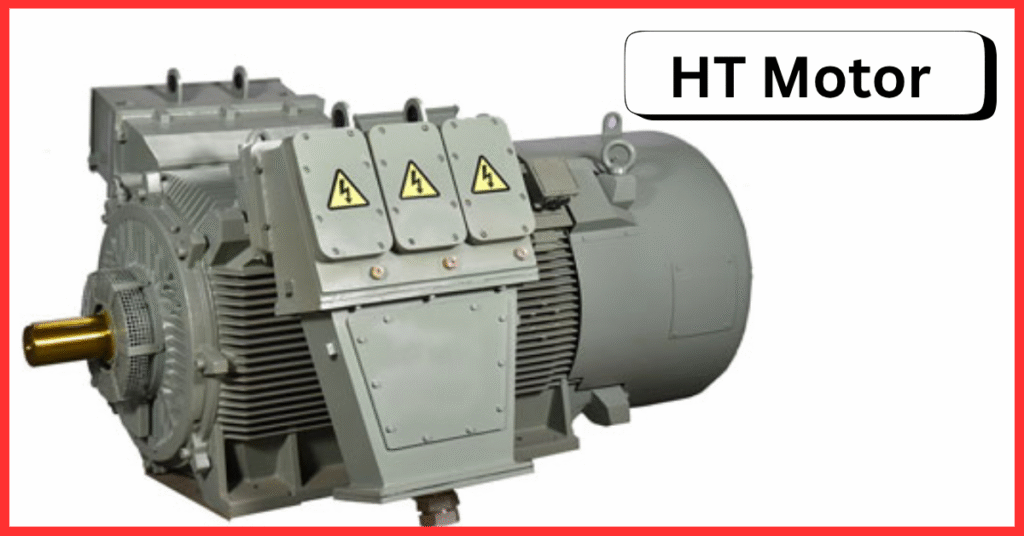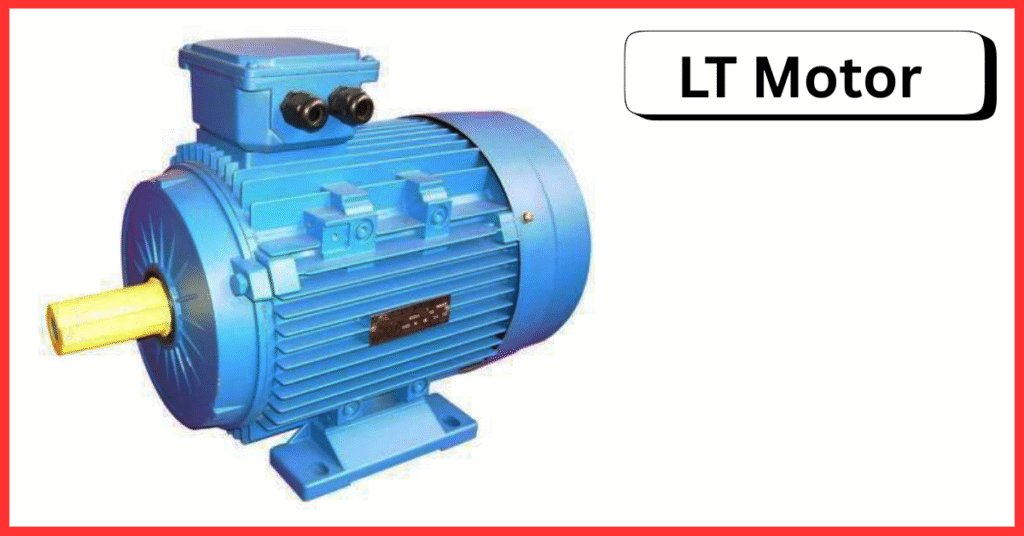HT and LT Motors are two crucial categories of electric motors commonly found in industrial plants and commercial facilities. The key difference between them lies in the voltage level at which they operate.
HT (High Tension) motors are designed for high-voltage AC systems, while LT (Low Tension) motors run on low-voltage supply. Understanding these differences is essential for engineers and designers to select the right motor based on factors such as power demand, safety standards, and energy efficiency.
In this article, we’ll cover the definitions, full forms, AC voltage ratings, key differences, typical applications, and how HT and LT Motors are classified under Indian and international standards.
What is a Motor?
A motor is an electrical machine that converts electrical energy into mechanical energy. It powers various machines like fans, pumps, compressors, and industrial equipment. Motors are broadly classified based on voltage, power capacity, and application—such as HT (High Tension) and LT (Low Tension) motors. You can explore more about electric motor types here.
What is an HT Motor?

HT Motor, short for High Tension Motor, is commonly referred to as a High Voltage AC Motor in industrial contexts. These motors operate at high AC voltage levels and are suited for heavy-duty applications requiring significant power and reliability.
HT Motor Full Form
HT stands for High Tension, indicating that the motor runs on high AC voltage.
Key Features of HT Motors:
- Voltage rating(AC): 3.3kV, 6.6kV, 11kV, or higher.
- Power range: Above 150 kW.
- Designed for heavy-duty loads.
- Lower current for the same power (reduces cable size and power loss).
- Requires specialized insulation and switchgear.
What is an LT Motor?

LT Motor, or Low Tension Motor, operates at AC voltage levels below 1,000 volts, commonly 415V in most countries. These motors are ideal for commercial facilities and small to medium-scale industries.
LT Motor Full Form
LT stands for Low Tension, signifying low-voltage AC operation.
Key Features of LT Motors:
- Voltage rating(AC): Typically 230V to 690V.
- Power range: Up to 150 kW.
- Commonly used for pumps, fans, conveyors, and compressors.
- Easier to maintain and install.
- Cost-effective for lower power requirements.
Classification of HT and LT Motors as per Indian and International Practices
While the general classification of motors into HT (High Tension) and LT (Low Tension) is globally accepted, the voltage range definitions differ slightly between Indian and American/European standards.
Indian Practice
- LT Motors: Operate at 230 V, 415 V, and 690 V
- HT Motors: Operate at 3.3 kV, 6.6 kV, and 11 kV
American/European Practice
- LT Motors: Operate at 230 V and 415 V
- Medium Voltage Motors: Operate at 690 V and 3.3 kV
- HT Motors: Operate at 6.6 kV and 11 kV
This variation in classification is important for engineers and designers when selecting motors for international projects or equipment import/export, to ensure compatibility with regional standards.
HT and LT Motor: Key Differences
Quick Comparison Table – HT vs LT Motor
| Aspect | HT Motor | LT Motor |
|---|---|---|
| Full Form | High Tension Motor | Low Tension Motor |
| Voltage Range(AC) | Above 1,000V (typically 3.3kV–11kV) | Below 1,000V (typically 415V) |
| Power Capacity | Generally >150 kW | Up to 150 kW |
| Applications | Heavy industries, power plants, large compressors | Small industries, commercial equipment |
| Cable Size & Losses | Smaller cable size, lower transmission losses | Larger cables, higher losses |
| Maintenance | Requires trained personnel and specialized tools | Easier to maintain |
| Cost | Higher initial and maintenance cost | Economical for small to mid-size needs |
| Safety Requirements | High insulation and protection gear needed | Standard safety measures sufficient |
Detailed Comparison by Category
Voltage Range
- HT Motor: Operates at high-voltage AC above 1,000V — typical ratings include 3.3kV, 6.6kV, and 11kV.
- LT Motor: Operates at low-voltage AC, usually 415V, for industrial/commercial use.
Power Capacity
- HT Motors are designed for high-power AC systems, usually exceeding 150 kW.
- LT Motors are suitable for systems up to 150 kW. They are ideal for smaller applications.
Applications
- HT Motors: Used in steel plants, cement factories, mining, and power generation.
- LT Motors: Common in HVAC, textile machines, agriculture equipment, and domestic setups.
Cable Size & Power Losses
- HT Motors: Their higher voltage results in lower current, which allows thinner cables and reduces I²R power losses.
- LT Motors: Due to lower voltage, they require higher current to deliver the same power, which necessitates thicker cables and results in higher I²R (copper) losses.
Maintenance
- HT Motors: Require specialized insulation, protective devices, and expert maintenance.
- LT Motors: Easier to install and maintain, requiring standard equipment and less technical expertise.
Cost
- HT Motors: More expensive due to complexity and high-grade components.
- LT Motors: Cheaper and simpler to install and maintain.
Safety Requirements
- HT Motors: Operate at dangerous voltage levels; need protective relays, grounding, and trained personnel.
- LT Motors: Safer and manageable with basic electrical safety protocols.
LT HT Motor Selection: Which One Should You Choose?
When choosing between HT and LT Motors, consider:
- Power Demand: Use HT motors for high-load applications like power stations and industrial drives.
- Budget: LT motors are cost-effective for smaller operations.
- Technical Requirements: HT motors demand high expertise and safety compliance, unlike LT motors.
Conclusion
The main difference between HT and LT Motor lies in the AC voltage rating, power capacity, and industrial use case. HT motors are designed for high-power, high-voltage AC applications, while LT motors are perfect for everyday low-voltage operations.
Choosing the right motor ensures optimal performance, cost efficiency, and safety. Assess your specific needs to determine whether an HT Motor or LT Motor best suits your application.
Related Articles: